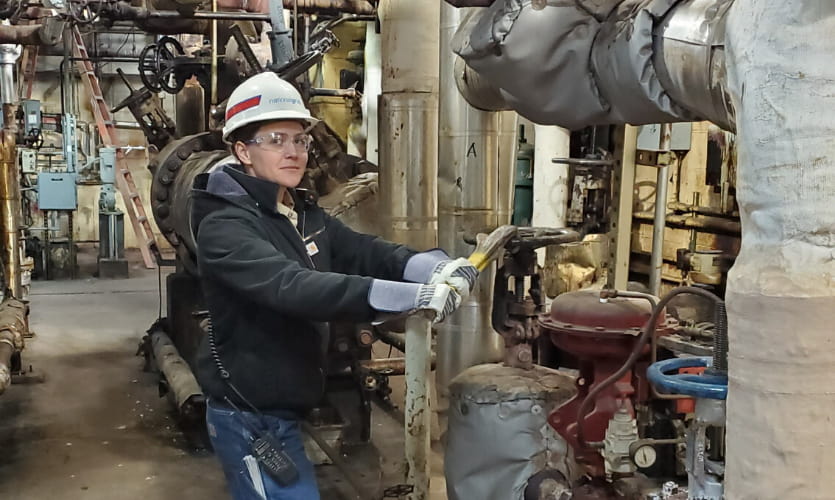About 200 volunteers at National Grid have volunteered to live at work for weeks at a time in order to maintain power to places like Boston and Long Island, where COVID-19 has struck especially hard. These men and women agreed to work 12-hour shifts for two to four consecutive weeks while bunking in offices, running and maintaining power plants throughout the Northeast to ensure uninterrupted service while minimizing the risk of contagion in the workforce.
Over thirty of the more than two hundred volunteers are sequestered at the National Grid’s power plants and gas turbine sites on Long Island. Lytx spoke with two such workers, Kristina Cirillo and Sean Kennedy, to understand why they volunteered and what their work has been like these past few weeks.
Kristina works at the Northport Power Station in Northport, New York, while Sean is stationed at the E.F. Barrett Power Station in Island Park, New York. Both stations supply power to the Long Island Power Authority and their 1.1 million electric customers.
Here’s an edited transcript of our recent interview with Kristina and Sean.
Q: Why are you both doing this?
Sean: I thought back to Hurricane Sandy, when everything just stopped. Everything was down, and I couldn’t check in on my mother. I had this feeling of helplessness then. With this, I wasn’t helpless. I could be part of the solution. It was a no-brainer for me.
Kristina: Someone has to do it. We’re providing power to New York hospitals, homes, and essential businesses. You do what you can to provide for your community.
Q: Tell us about your jobs. What do you do?
Kristina: Sean and I are assistant control room operators. I work at the Northport Power Station in Northport, New York. Each plant has a control room operator who’s in a room monitoring everything that’s going on in the plant. The assistant is the hands and feet of the control room operator. While they’re in the control room, I’m in the plant operating the valves, looking at the equipment, doing the physical upkeep on the equipment. On a 12-hour shift, I walk about six miles around the plant, going up and down stairs checking and maintaining the equipment.
Q: How has that changed for you?
Sean: The shifts are two weeks long. The first week, I worked 12 hours during the day. The second week, I’m working the night shift. We switch off at 6 am and 6 pm, with some overlap in between where the person going off the shift catches up with the one coming on about what was done and what needs to be worked on.
Kristina: There are zones that are sequestered for us. We’ve been sleeping in people’s offices, while the people who were in those offices are now working out of trailers. No one’s been upset about having to give up their offices. Everyone’s been in really good spirits. For me, because I’m the only female in the crew, I also have full use of the women’s locker room, which is nice.
Q: What’s it like to live at work 24/7?
Kristina: The company has provided us with everything we need – cots, blankets, sheets. Our meals are all catered so we don’t have to cook. One of the caterers is a local bakery, and they have this amazing crumb cake. If we don’t like the catered options, the refrigerator is fully stocked. People have been putting on barbecues, and we’ve been really looking forward to the cookouts.
Sean: It’s been a lot more pleasant than I thought it would be. The company has made it feel as much like home as it can be. I brought along a 3,000-piece puzzle, even though I hadn’t done a puzzle in a good 20-something years. I put it in the break room, and it’s fun to watch it slowly coming together as people work on it. It’s been good for building camaraderie.
Dave Emig, Control Operator B (left); Sean Kennedy Assistant Control Room Operator (second from right); Rich Hull, Watch Engineer (right) at E.F. Barrett Power Station in Island Park, New York. Credit: National Grid
Q: Is it hard not to be home?
Kristina: I have an 8-year-old daughter at home, and I do FaceTime with her and my husband every day. I have a military background with the U.S. Navy. I’d be stationed on aircraft carriers in the Pacific for months at a time, with no access to the internet. That experience gives me an easier mindset to be able to do this. A lot of other guys here have experience along those lines as well.
Sean: Both of my parents are getting up there in age. It’s tough being away from them. Like Kristina, I have maritime experience. I was a merchant marine working two weeks on, two weeks off on container ships and tugboats. Having that experience makes this easier, more manageable. You just have to settle into a routine.
Q: Would you volunteer to do this again?
Sean: As long as it takes. I’d rather be doing this than sitting at home doing household chores.
Kristina: It’s funny, I asked my husband just yesterday whether he would be okay with me doing this again. My husband is the one holding down the fort at home, taking care of my daughter and our dog while working. He has a full plate. When I volunteer to do this, it’s not just me, it’s really a family commitment. He said he was fine with it because he understands the need.
